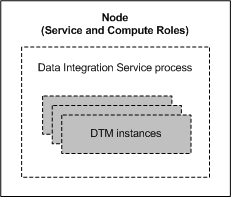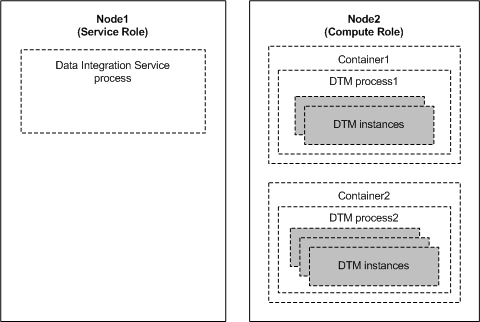Process Where DTM Instances Run
Based on how you configure the Data Integration Service, DTM instances can run in the Data Integration Service process, in a separate DTM process on the local node, or in a separate DTM process on a remote node.
A DTM process is an operating system process that the Data Integration Service starts to run DTM instances. Multiple DTM instances can run within the Data Integration Service process or within the same DTM process.
The Launch Job Options property on the Data Integration Service determines where the service starts DTM instances. Configure the property based on whether the Data Integration Service runs on a single node or a grid and based on the types of jobs that the service runs.
The following table lists each process where DTM instances can run:
Process Where DTM Instances Run | Data Integration Service Configuration | Types of Jobs |
|---|
In the Data Integration Service process | Single node or grid | SQL data service and web service jobs on a single node or on a grid where each node has both the service and compute roles. Advantages: SQL data service and web service jobs typically achieve better performance when the Data Integration Service runs jobs in the service process. |
In separate DTM processes on the local node | Single node or grid | Mapping, profile, and workflow jobs on a single node or on a grid where each node has both the service and compute roles. Advantages: When the Data Integration Service runs jobs in separate local processes, stability increases because an unexpected interruption to one job does not affect all other jobs. |
In separate DTM processes on remote nodes | Grid | Mapping, profile, and workflow jobs on a grid where nodes have a different combination of roles. Advantages: When the Data Integration Service runs jobs in separate remote processes, stability increases because an unexpected interruption to one job does not affect all other jobs. In addition, you can better use the resources available on each node in the grid. When a node has the compute role only, the node does not have to run the service process. The machine uses all available processing power to run mappings. |
Note: Ad hoc jobs, with the exception of profiles, can run in the Data Integration Service process or in separate DTM processes on the local node. Ad hoc jobs include mappings run from the Developer tool or previews, scorecards, or drill downs on profile results run from the Developer tool or Analyst tool. If you configure a Data Integration Service grid to run jobs in separate remote processes, the service runs ad hoc jobs in separate local processes.
In the Data Integration Service Process
To run DTM instances in the Data Integration Service process, configure the Data Integration Service to launch jobs in the service process. Configure DTM instances to run in the Data Integration Service process when the service runs SQL data service and web service jobs on a single node or on a grid.
SQL data service and web service jobs typically achieve better performance when the Data Integration Service runs jobs in the service process.
The following image shows a Data Integration Service that runs DTM instances in the Data Integration Service process:
In Separate DTM Processes on the Local Node
To run DTM instances in separate DTM processes on the local node, configure the Data Integration Service to launch jobs in separate local processes. Configure DTM instances to run in separate DTM processes on the local node when the Data Integration Service runs mapping, profile, and workflow jobs on a single node or on a grid where each node has both the service and compute roles.
When the Data Integration Service runs jobs in separate local processes, stability increases because an unexpected interruption to one job does not affect all other jobs.
The following image shows a Data Integration Service that runs DTM instances in separate DTM processes on the local node:
In Separate DTM Processes on Remote Nodes
To run DTM instances in separate DTM processes on remote nodes, configure the Data Integration Service to launch jobs in separate remote processes. Configure DTM instances to run in separate DTM processes on remote nodes when the Data Integration Service runs mapping, profile, and workflow jobs on a grid where nodes can have a different combination of roles.
When the Data Integration Service runs jobs in separate remote processes, stability increases because an unexpected interruption to one job does not affect all other jobs. In addition, you can better use the resources available on each node in the grid. When a node has the compute role only, the node does not have to run the service process. The machine uses all available processing power to run mappings.
The following image shows two of many nodes in a Data Integration Service grid. Node1 has the service role, and Node2 has the compute role. The Data Integration Service process on Node1 manages application deployments, logging, job requests, and job optimizations. The Service Manager on Node2 runs DTM instances in separate DTM processes started within containers.



